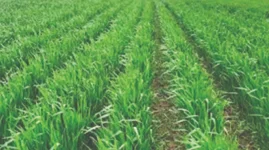Zimbabwe plans to grow wheat on 120,000 hectares this year. This marks a big milestone as they try to boost food security and cut down on imports. Their goal is to produce 600,000 tonnes of wheat, which beats last year's 562,591 tonnes. The country only needs 360,000 tonnes to feed everyone, making it self-sufficient with plenty left over.
The 2025 winter plan builds on what worked during the 2024 Wheat-Based Food Security program. Farmers planted nearly 120,000 hectares last season. They also grew 6,697 hectares of barley, yielding 36,120 tonnes, plus 8,657 hectares of potatoes, producing 233,739 tonnes. This year, they aim for 6,500 hectares of barley, making 39,000 tonnes, and expect potato harvests around 236,250 tonnes.
Leonard Munamati serves as acting chief director for Agricultural and Rural Development Advisory Services. He stated that the government stands ready with partners to support wheat farmers. The support comes through private contractors, the National Enhanced Agricultural Productivity Scheme, the Presidential Wheat Support Scheme, and farmers who pay their costs themselves.
CBZ Agro-Yield wants to plant 10,000 hectares with expected yields averaging 4.8 tonnes per hectare, totaling around 55,000 tonnes. AFC Land Bank plans 18,000 hectares, producing about 81,000 tonnes. Self-financed growers might plant 1,000 hectares, yielding 15,000 tonnes. The Presidential scheme targets 5,000 hectares aiming for 17,500 tonnes of wheat production.
The country started early preparations for both summer and winter growing seasons to strengthen food security. Officials focus heavily on boosting wheat output to meet national needs. These efforts align with several national plans, including the Agriculture and Food Systems Transformation Strategy. The ultimate vision aims to become an upper-middle-income society by 2030.
Government agencies work together to create good wheat-growing conditions. The Ministry of Lands collaborates with electricity providers and water authorities since wheat requires reliable irrigation and power. Farmers often form clusters to help prioritize electricity delivery. These practical steps help address key production challenges.
Depinah Nkomo leads the Zimbabwe Indigenous Women Farmers Trust. She emphasizes that farmers need proper training on planting methods, fertilizer use, and fighting plant diseases. She mentions that irrigation water seems guaranteed for the upcoming season. Many farmers have already started clearing fields, especially where irrigated tobacco grew before.
Thanks to heavy rains during the second half of the growing season, farmers feel optimistic about harvest potential. Nkomo urged those near dams to use water efficiently for better crop yields. She predicted dams will fill up soon, which should boost agricultural activities. Her organization expects increased production from winter wheat as a result.
Dr. Shadreck Makombe heads the Zimbabwe Commercial Farmers Union. He encourages farmers to collect rainwater for sustainable irrigation during winter months. He expresses confidence about upcoming harvests following good rainfall patterns. Makombe stresses proper farming practices as key to better productivity. Rising water levels in dams signal promising conditions for winter crops, leading him to advise farmers to begin preparations immediately.
The 2025 winter plan builds on what worked during the 2024 Wheat-Based Food Security program. Farmers planted nearly 120,000 hectares last season. They also grew 6,697 hectares of barley, yielding 36,120 tonnes, plus 8,657 hectares of potatoes, producing 233,739 tonnes. This year, they aim for 6,500 hectares of barley, making 39,000 tonnes, and expect potato harvests around 236,250 tonnes.
Leonard Munamati serves as acting chief director for Agricultural and Rural Development Advisory Services. He stated that the government stands ready with partners to support wheat farmers. The support comes through private contractors, the National Enhanced Agricultural Productivity Scheme, the Presidential Wheat Support Scheme, and farmers who pay their costs themselves.
CBZ Agro-Yield wants to plant 10,000 hectares with expected yields averaging 4.8 tonnes per hectare, totaling around 55,000 tonnes. AFC Land Bank plans 18,000 hectares, producing about 81,000 tonnes. Self-financed growers might plant 1,000 hectares, yielding 15,000 tonnes. The Presidential scheme targets 5,000 hectares aiming for 17,500 tonnes of wheat production.
The country started early preparations for both summer and winter growing seasons to strengthen food security. Officials focus heavily on boosting wheat output to meet national needs. These efforts align with several national plans, including the Agriculture and Food Systems Transformation Strategy. The ultimate vision aims to become an upper-middle-income society by 2030.
Government agencies work together to create good wheat-growing conditions. The Ministry of Lands collaborates with electricity providers and water authorities since wheat requires reliable irrigation and power. Farmers often form clusters to help prioritize electricity delivery. These practical steps help address key production challenges.
Depinah Nkomo leads the Zimbabwe Indigenous Women Farmers Trust. She emphasizes that farmers need proper training on planting methods, fertilizer use, and fighting plant diseases. She mentions that irrigation water seems guaranteed for the upcoming season. Many farmers have already started clearing fields, especially where irrigated tobacco grew before.
Thanks to heavy rains during the second half of the growing season, farmers feel optimistic about harvest potential. Nkomo urged those near dams to use water efficiently for better crop yields. She predicted dams will fill up soon, which should boost agricultural activities. Her organization expects increased production from winter wheat as a result.
Dr. Shadreck Makombe heads the Zimbabwe Commercial Farmers Union. He encourages farmers to collect rainwater for sustainable irrigation during winter months. He expresses confidence about upcoming harvests following good rainfall patterns. Makombe stresses proper farming practices as key to better productivity. Rising water levels in dams signal promising conditions for winter crops, leading him to advise farmers to begin preparations immediately.












